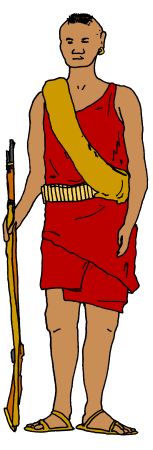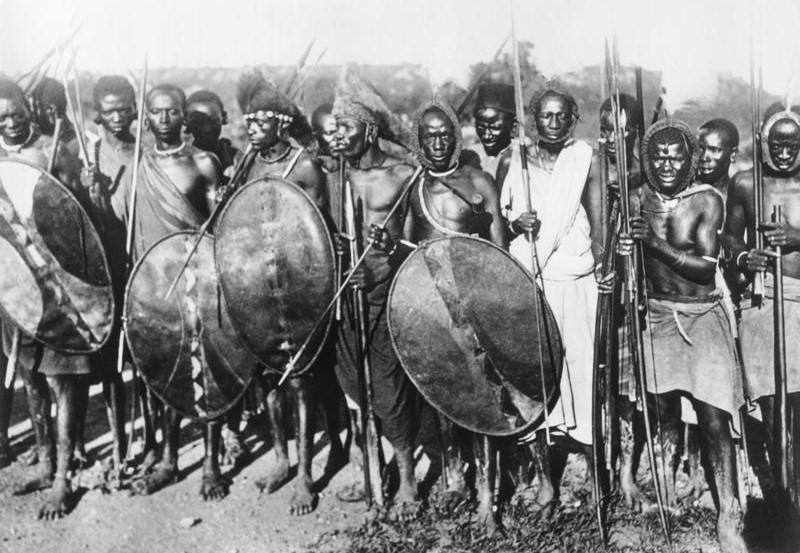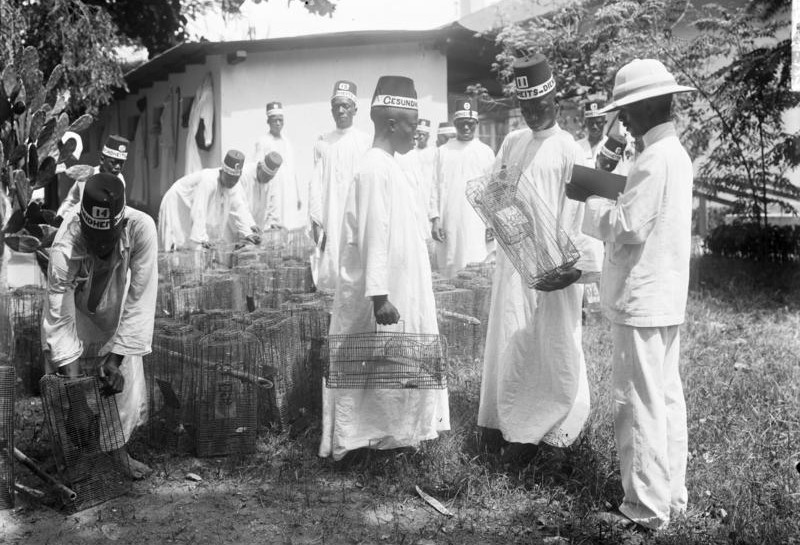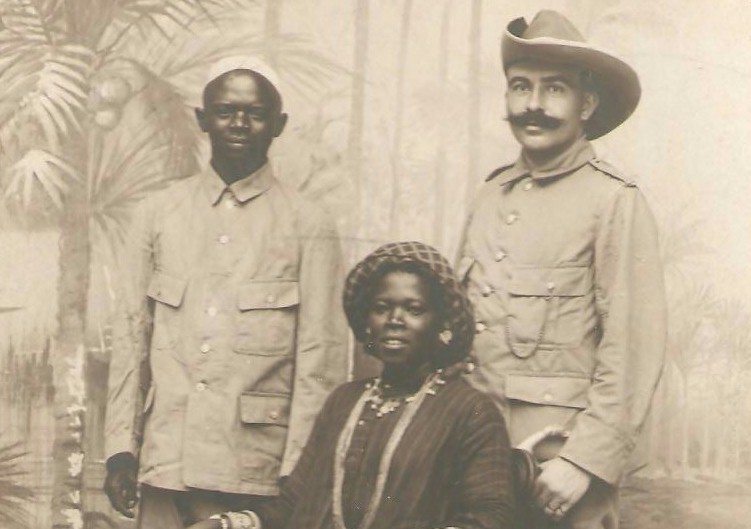|
German East Africa
African Auxiliaries
|

Figure 1
Ruga-Ruga |
Not only did the Germans employ askaris for the
Schutztruppe and
Polizeitruppe, they also employed large numbers of Africans to
serve in many other combatant and non-combatant roles. No uniform regulations were
issued for these auxiliary personnel and the only sources to go from are
contemporary photographs and illustrations.
Ruga-Ruga
The Germans employed and
armed large numbers of African irregular troops (known as "Ruga-Ruga") in
their forces as skirmishers and light escorting infantry. Numbers of
Ruga-Ruga were attached on a semi-permanent basis to the Schutztruppe
Feldkompagnien.
The Ruga-Ruga had no standard uniform, they
usually wore coloured loin cloths, sometimes long enough
to wrap over the shoulder or simple smocks also fashioned from coloured
cloth. Some contemporary illustrations show the Ruga-Ruga more
elaborately dressed with striped cloths and headdress decorated with feathers.
Some irregulars were armed with German Mauser
rifles but
many carried older firearms, hunting rifles, old percussion caps and
spears. On display in the Imperial War Museum in London is an old .60
inch percussion cap musket captured from German forces in East Africa.
The musket has a very interesting history having been sold by the
United States to France after the American Civil War, captured by the
Prussians in 1870 and was still in service in the 1914-18 war.
Figure 1 (on the left) is
based on a photograph of a Ruga-Ruga Irregular Soldier taken in
about 1917. They usually had no uniform at all
and often wore their traditional tribal costumes. This figure
typically wears a dark red cloth or blanket wrapped around his lions and
shoulder. He has
sandals but many Ruga-Ruga were barefoot. As with this figure most
Ruga-Ruga carried
ammunition bandoliers along with locally made water bottles, knapsacks,
machetes and
blankets. The other figures in the original photograph upon which
this illustration is based are dressed
equally casually, some with battered old askari tunics and some with non-regulation fezzes with a single
feather stuck in the top. They are all armed with breech loading
rifles, probably the Jägerbüsche 71.
|
|
| |
|
|
| |
Friendly Tribes
As well as recruiting individual
scouts from local tribes, the Germans
would sometimes employ (and often arm) war parties from friendly tribes to turn against their
hostile neighbours. For
some examples, the once rebellious He-he fought alongside the Germans against
the Maji-Maji rebels. The Massai as well sided with the Germans during
the rising of the Iraku in 1906 towards the end of the Maji-Maji Rebellion
and supplied hundreds of warriors. And the Sultan of Bukoba's
warriors were given 400 Jägerbüsche 71 rifles in September 1914 to help
fight alongside the Schutztruppe.
These warriors wore their traditional tribal dress which would vary from
tribe to tribe. Many had decorated plaited hair or partially shaven heads,
some wore loin cloths others, simple plaited thongs or even less. Most were
armed with spears and decorated shields although as mentioned above others
had firearms either from the Germans or private traders.
Recommended Reading- "Warrior Peoples of East Africa 1840–1900" by CJ
Peers, published by
Osprey
The Sultan of Bukoba, Kahigi Kanassi wore a German
Cuirassier style uniform similar to that worn by the
Sultan of
Bamum in Cameroon. And at least some of his men wore European style
uniforms- white tunics and trousers with red fezzes.
Recommended External Link - Axis
History Forum Discussion on the
Sultan of Bukoba's Force
|
|
| |
|
|
| |
Porters
The German forces needed a large number of
locally recruited porters to carry their supplies and equipment on campaign across many miles and
varieties of terrain. Often their families and cattle travelled with
them behind the Schutztruppe columns. These porters were usually
seen dressed lightly and poorly, in simple shirts with tied skirts or
shorts, none of which were uniform.
Naval Auxiliaries
African sailors were employed by the German colonial
government to man craft on the great lakes. These men and their uniforms are
described on the
Naval Auxiliaries Page of this
website.
Other Non-Combatant Africans Employed by the Schutztruppe
The Schutztruppe and colonial government in East Africa
also employed large numbers of Africans as guides, servants, cooks,
hospital staff, railway and armaments workers and by 1914 as aircraft ground crew.
As with other auxiliaries they usually wore no uniform at all, just loin
cloths. Occasionally servants did wear cast off Schutztruppe uniform items
and from photographs it seems hospital staff were also sometimes
uniformed.
Figure 2 (on the right) is based on a
pre-war photograph of a Hospital Askari NCO. This askari attached to
hospital duties unusually wears a German hospital assistant's white tunic- of
the same cut as the Schutztruppe tunic with brass buttons and with Schutztruppe
white/red/black twisted braid shoulder straps but without the usual Schutztruppe blue
piping. On the upper left sleeve is a white circular badge bearing a medical red cross
(see Specialist Insignia Page).
Often a simple red cross armband was worn instead. Below this is his rank insignia- two chevrons for Schausch or corporal. Both
German and African medical NCOs in East Africa wore gold chevrons on a black background (see
right). He wears a watch chain from the left breast pocket to the third tunic
button.
Aside from the tunic he is dressed
similarly to most East African askaris with the tarbush and white metal eagle,
brown belt with plain brass buckle, bayonet, khaki trousers, brown boots and
dark blue/grey puttees.
|

Figure 2
Hospital
Askari NCO |
| |
|
|
|
|
| |
Period
Photographs

African
Tribal Warriors in German Service
Photo by Paul
Hoffmann from Bundesarchiv /
WikiCommons

African
Porters during the First World War
Photo from Bundesarchiv /
WikiCommons

African Medical Assistants
Note "Gesundheits-dienst" or medical service, on
their fezzes
Photo by Walther Dobbertin from
Bundesarchiv /
WikiCommons

A Schutztruppe NCO, his servant and an
unknown woman.
The servant wears a Schutztruppe
khaki uniform without shoulder straps, possibly one of the officer's
cast offs.
Photo
© Peter Klein |
|
| |
|
|
| |
|
|
|
|